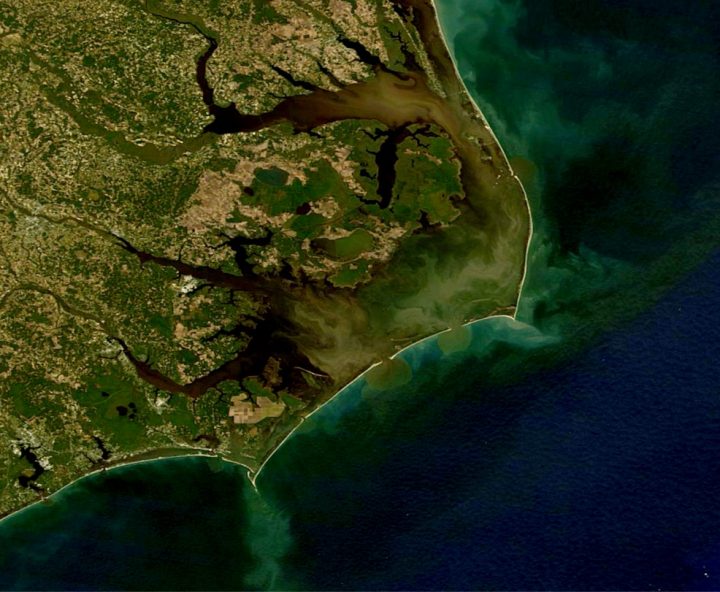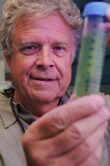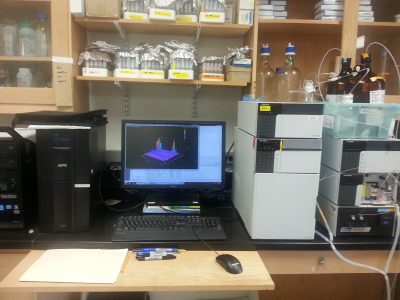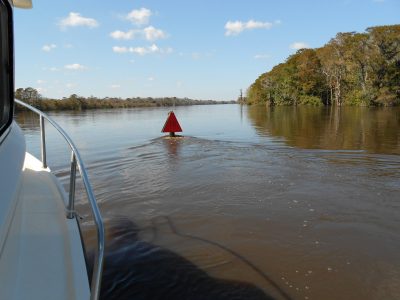
MOREHEAD CITY – Hans Paerl has a good idea of his perfect storm.
“If I had to choose what kind of storm I’d want, in terms of minimizing water quality impacts, just from what we’ve learned, you want a fast-moving storm with relatively little rain, get it over with fast, minimal impacts on the watershed,” he said.
Supporter Spotlight

After more than 20 years of studying the Neuse River estuary and Pamlico Sound, Paerl is well-qualified to characterize the relationship between hurricanes and coastal water quality. Paerl, professor of marine and environmental sciences at the University of North Carolina Institute of Marine Sciences in Morehead City, and his colleagues have analyzed water samples, built models, deployed instruments and collected data via ferry to better understand the Neuse-Pamlico system.
In the meantime, the climate has been changing, with more frequent severe storms counted among potential consequences. As the baseline shifts, scientists are faced with the challenge of isolating the effects of hurricanes.
To that end, Paerl and other researchers performed a “comparison, of all these different properties, like salinity and nutrient concentrations and phytoplankton biomass, following storms compared to non-storm periods during the storm season, which was May through October,” said Nathan Hall, a research scientist at UNC IMS. “How does (storm activity) really stack up compared to the natural variability of weather in eastern North Carolina?”
The answer, recently published in Biogeochemistry, summarizes major trends that the researchers extracted from their troves of data. In general, they found that hurricanes swept organic matter through the Neuse River estuary, contributed to phytoplankton blooms, and even released carbon dioxide from the water into the atmosphere.
“There’s a lot of useful information there for management,” Paerl said, “but also I think for the public at large, just to know what the water quality and for the bigger-picture impacts are going to be, particularly with higher frequency (of storms).”
Supporter Spotlight
Hall agreed.
“The main effects of storms are wind, storm surge, and precipitation and the flooding associated with it,” Hall said. “So those are the three main things that affect the ecology or the people that live around the waterbody.”
Paerl explained that those features could vary among individual storms, with disparate environmental consequences.
“The individuality really matters a lot in terms of how much gets in (the estuary), nutrient-wise and carbon-wise, but also (in terms of) the subsequent impact on secondary effects, like algal blooms, low oxygen, fish kills,” Paerl said.
Organic Matter on the Move
As rain falls on land, it sweeps away all types of debris. “These large hurricane systems drastically alter how much organic matter is flushed from the watershed into the estuary and sound and represents a significant fraction of the annual carbon load,” said Alexandria Hounshell, a doctoral student at UNC.

Organic matter refers to plant or animal matter in varying stages of decay. Larger bits, like pieces of leaves or chunks of tree trunk, are classified as particulate organic carbon, or POC, whereas dissolved organic carbon, or DOC, has been broken down into pieces small enough to pass through a paper filter.
Hounshell said that satellite photos reveal the impact of organic matter delivery: The Neuse looks browner after storms. That’s also evident from analyzing post-hurricane water samples, which have higher concentrations of DOC.
“We get floods without tropical cyclones, but we get big floods with tropical cyclones that really put a lot of water out onto areas that don’t normally get wet, and that changes things like how much DOC is going to be delivered,” Hall said.
The researchers use the ratio of carbon to nitrogen in organic matter to confirm that it came from land, as opposed to originating in the estuary.
Under normal circumstances, microbes in the Neuse can break down some DOC before it reaches Pamlico Sound, but that’s not always the case.
“For example, following Hurricane Matthew we found that the vast majority of the huge influx of DOC to the Neuse from the river water was simply passed right along to the Pamlico Sound with little degradation,” Hounshell said.
She explained that more frequent extreme weather events could result in repeated deliveries of DOC to Pamlico Sound. That could lead to murkier water in the sound’s fish habitat.
According to Paerl, strategies such as no-till agriculture or riparian buffers could temper DOC loadings. Such practices could help by “keeping things on the land as much as possible and allowing processes that deal with nutrients and carbon to occur in the soils and in the watershed as opposed to in estuarine and coastal systems,” he said.
Phytoplankton in Living Color
In addition to organic matter, stormwater washes nutrients such as nitrogen and phosphorus into estuaries. Nutrients can fuel the growth of phytoplankton, which can become problematic in high concentrations.
Whereas one can walk through a forest and identify plants by sight, it’s generally not possible to know which phytoplankton are present in a water sample at a glance. Karen Rossignol, a research technician at UNC IMS, uses a technique known as high-performance liquid chromatography, or HPLC, to describe phytoplankton.

Rossignol processes water samples to extract pigments from phytoplankton. Pigments like chlorophyll a give plants distinctive colors. “Each pigment has a very signature spectrum to it of what light’s absorbed and reflected, and from that I can identify what pigments are present,” she said.
Rossignol explained that some pigments are more likely associated with certain types of phytoplankton. She can use that information to understand trends in phytoplankton presence and abundance in the estuaries.
At least, that’s the way it works in theory. “The Neuse is a very, very complicated system,” Rossignol said. “There are a lot of different algae, and some of them have the same pigments.” She cautions that, especially over a long period, “it is difficult to say just one thing about all the pigments in general, except for the fact that it is very complicated and very involved and very variable.”
Disclaimers aside, Rossignol has managed to find some signals in the noise. “You’ll see some of these pretty persistent dinoflagellate blooms that occur, and they last sometimes for many, many months and over large sections of the estuary,” she said. Dinoflagellates have been in the news recently as the cause of Florida’s persistent red tide.
Blooms have also been documented during non-storm conditions, and Rossignol pointed out that the frequency of dinoflagellate blooms has increased over the past 10 years. The pigment records also reveal the impacts of specific storms, such as a spike in a pigment associated with cyanobacteria after Hurricane Joaquin.
“I’m hoping, with funding, that we can continue working on this and also continue to better give recommendations on how we can help these systems recover from eutrophication and from nutrient input,” Rossignol said.
Excuse You, Estuary
This study also expanded on the idea that estuaries may be sources of carbon dioxide, or CO2 after storms.
“These coastal ecosystems can accumulate a lot of carbon over time, but they can lose it even faster,” said Joey Crosswell, a biogeochemist for the Commonwealth Scientific and Industrial Research Organisation, or CSIRO, Oceans and Atmosphere who contributed to the research as a doctoral student at UNC. “(Major storms) stir up an otherwise stable carbon reservoir, like coastal sediments, which leads to a large release, or ‘burp,’ of CO2 to the atmosphere.”

In the face of climate change, scientists have been working to identify global sources of carbon dioxide. It could be important for them to include storm-induced burps from estuaries on that list, especially if hurricanes become more frequent.
Whether storms rush in with pounding rains or driving winds, they have the potential to release carbon dioxide. Windy hurricanes can churn up the estuary, ventilating carbon dioxide accumulated in water near the bottom, explained Bryce Van Dam, a postdoctoral researcher at Florida International University who recently completed his doctoral studies at UNC.
“In addition to that, you have resuspension of sediments because (if) there’s enough wind energy, it whips up waves that are big enough to mix up sediments from the bottom, and all the CO2 that was dissolved in porewater is then also released to the atmosphere,” Van Dam said. Porewater refers to the tiny volumes of water trapped in the spaces between sediment particles.
Hurricanes may also bring unusual amounts of rain to upland habitats like forests or wetlands. As the water seeps into the ground, it picks up porewater that had been trapped in the soil, accumulating carbon dioxide respired by roots and microbes. “And that high CO2 water then gets flushed into rivers and down into receiving estuaries during flooding events following wet storms,” Van Dam said.
There are still some unresolved questions, such as resolving the physics of sediment movement, but the wealth of data has allowed the researchers to confidently sketch out the estuarine carbon cycle.
“The long-term dataset in the Neuse-Pamlico is one of the most comprehensive for any estuary in the world,” Crosswell said. “After six years of CO2 surveys, we also now have one of the best resolved datasets for estuarine CO2 fluxes. Coordination of intensive, targeted field work and long-term monitoring is a powerful research tool. This allowed us to identify the major drivers of coastal carbon cycling, and then put these in a broader context by looking at these same drivers in the long-term dataset.”
Overall, the study demonstrates the value of routine monitoring that captures unpredictable events.
“Without having that monitoring in place, you would not be able to assess natural or man-imposed impacts or changes in these systems,” Paerl said.
In its own way, the work may also be a perfect storm – a detailed and methodical snapshot that helps explain a habitat on the verge of change.







